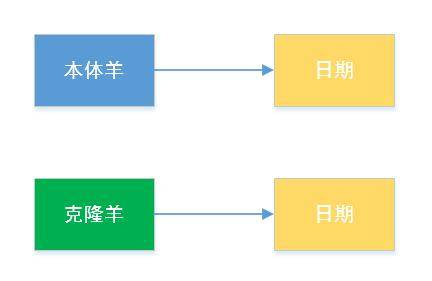一、前言
本篇介绍 Java 设计模式中创建型模式的最后一种--原型模式。上篇设计模式主题为 《Java 设计模式之建造者模式(四)》
二、简单介绍
原型模式是一种对象创建型模式,它采取复制原型对象的方法来创建对象的实例。使用原型模式创建的实例,具有与原型一样的数据。
2.1 特点
由原型对象自身创建目标对象。即对象创建这一动作发自原型对象本身。
目标对象是原型对象的一个克隆。即通过原型模式创建的对象,不仅仅与原型对象具有相同的结构,还与原型对象具有相同的值。
根据对象克隆深度层次的不同,有浅度克隆与深度克隆。
2.2 应用场景
在创建对象的时候,我们不只是希望被创建的对象继承其父类的基本结构,还希望继承原型对象的数据。
希望对目标对象的修改不影响既有的原型对象(深度克隆的时候可以完全互不影响)。
隐藏克隆操作的细节。很多时候,对对象本身的克隆需要涉及到类本身的数据细节。
三、实现方式
我们以克隆羊为例,实现类需要实现 Cloneable 接口,同时要重写从 Object 类中继承的 clone 方法:
1
2
3
4
5
6
7
8
9
10
11
12
13
14
15
16
17
18
19
20
21
22
23
24
25
26
27
28
| public class Sheep implements Cloneable{
private String name;
private Date birthday;
public String getName() {
return name;
}
public void setName(String name) {
this.name = name;
}
public Date getBirthday() {
return birthday;
}
public void setBirthday(Date birthday) {
this.birthday = birthday;
}
@Override
protected Object clone() throws CloneNotSupportedException {
return super.clone();
}
}
|
客户端:
1
2
3
4
5
6
7
8
9
10
11
12
13
14
15
| public class Client {
public static void main(String[] args) throws CloneNotSupportedException {
Date date = new Date(1365215478956L);
Sheep sheep = new Sheep();
sheep.setName("多利");
sheep.setBirthday(date);
Sheep clone = (Sheep) sheep.clone();
System.out.println("克隆羊名字:" + clone.getName());
System.out.println("克隆羊生日:" + clone.getBirthday());
}
}
|
结果:
1
2
| 克隆羊名字:多利
克隆羊生日:Sat Apr 06 10:31:18 CST 2013
|
当我们需要更多的羊时,只需调用第一只羊的 clone 方法即可,省去了给新建的对象设置属性的操作。
不过,上边的克隆方式属于浅度克隆,当对象中包含引用类型的属性时,这样浅克隆方式会存在一个问题。我们试着修改 date 的值:
1
2
3
4
5
6
7
8
9
10
11
12
13
14
15
16
17
18
19
20
21
22
| public class Client {
public static void main(String[] args) throws CloneNotSupportedException {
Date date = new Date(1365215478956L);
Sheep sheep = new Sheep();
sheep.setName("多利");
sheep.setBirthday(date);
Sheep clone = (Sheep) sheep.clone();
System.out.println("克隆羊名字:" + clone.getName());
System.out.println("克隆羊生日:" + clone.getBirthday());
System.out.println("--------------------------------");
// 修改本体羊生日
date.setTime(3246584261356L);
System.out.println("本体羊生日:" + sheep.getBirthday());
System.out.println("克隆羊生日:" + clone.getBirthday());
}
}
|
结果打印:
1
2
3
4
5
| 克隆羊名字:多利
克隆羊生日:Sat Apr 06 10:31:18 CST 2013
--------------------------------
本体羊生日:Thu Nov 17 12:57:41 CST 2072
克隆羊生日:Thu Nov 17 12:57:41 CST 2072
|
我们修改本体羊的日期,结果克隆羊的日期也发生变化。
因为浅度克隆只对基本数据类型的值进行备份,而引用类型的数据只是拷贝了指向对象的引用而已。其内存表现形式如下图:
![]()
从图中可知,两只羊共用一个日期对象。因此,当我们修改日期时,两只羊的日期也发生变化。
为了解决这一个问题,我们可以使用深度克隆方式,有 2 种方式可以实现深度克隆。
方式一:在 clone 方法中将所有引用类型数据进行克隆。
实体类:
1
2
3
4
5
6
7
8
9
| @Override
protected Object clone() throws CloneNotSupportedException {
Object obj = super.clone();
Sheep sheep = (Sheep) obj;
// 克隆时间
sheep.birthday = (Date) this.birthday.clone();
return sheep;
}
|
在实体类的 clone 方法中,将引用类型的数据一起克隆。
在运行客户端代码时,结果如下:
1
2
3
4
5
| 克隆羊名字:多利
克隆羊生日:Sat Apr 06 10:31:18 CST 2013
--------------------------------
本体羊生日:Thu Nov 17 12:57:41 CST 2072
克隆羊生日:Sat Apr 06 10:31:18 CST 2013
|
方式二:使用序列化和反序列化进行克隆
因为所有序列化方式,因此实体必须实现 Serializable 接口。
实体类:
1
2
3
| public class Sheep implements Cloneable,Serializable{
...
}
|
客户端:
1
2
3
4
5
6
7
8
9
10
11
12
13
14
15
16
17
18
19
20
21
22
23
24
25
26
27
28
| public class Client {
public static void main(String[] args) throws CloneNotSupportedException,ClassNotFoundException, IOException {
Date date = new Date(1365215478956L);
Sheep sheep = new Sheep();
sheep.setName("多利");
sheep.setBirthday(date);
//通过序列化和反序列化进行克隆
ByteArrayOutputStream bos = new ByteArrayOutputStream();
ObjectOutputStream oos = new ObjectOutputStream(bos);
oos.writeObject(sheep);
ByteArrayInputStream bis = new ByteArrayInputStream(bos.toByteArray());
ObjectInputStream ois = new ObjectInputStream(bis);
Sheep clone = (Sheep) ois.readObject();
System.out.println("克隆羊名字:" + clone.getName());
System.out.println("克隆羊生日:" + clone.getBirthday());
System.out.println("--------------------------------");
// 修改本体羊生日
date.setTime(3246584261356L);
System.out.println("本体羊生日:" + sheep.getBirthday());
System.out.println("克隆羊生日:" + clone.getBirthday());
}
}
|
打印结果与方式一的结果一致。
深度克隆的内存表现形式如下图:
![]()
四、性能比较
使用原型模式创建对象并不会调用类的构造方法。因此,在构造函数调用长且需要重复创建该类的实例的情况下,使用原型模式创建对象的优势就体现出来了。
实体类:
1
2
3
4
5
6
7
8
9
10
11
12
13
14
15
16
17
18
19
20
21
22
23
24
25
26
27
28
29
30
31
32
33
34
35
36
| public class Sheep implements Cloneable{
private String name;
private Date birthday;
public Sheep() {
try {
Thread.sleep(10);
} catch (InterruptedException e) {
e.printStackTrace();
}
}
public String getName() {
return name;
}
public void setName(String name) {
this.name = name;
}
public Date getBirthday() {
return birthday;
}
public void setBirthday(Date birthday) {
this.birthday = birthday;
}
@Override
protected Object clone() throws CloneNotSupportedException {
return super.clone();
}
}
|
延迟构造器调用的时间。
客户端:
1
2
3
4
5
6
7
8
9
10
11
12
13
14
15
16
17
18
19
20
21
| public class Client {
public static void main(String[] args) throws CloneNotSupportedException {
Sheep sheep = new Sheep();
int num = 1000;
long t1 = System.currentTimeMillis();
for (int i = 0; i < num; i++) {
Sheep tmp = new Sheep();
}
System.out.println("new 方式耗时:" + (System.currentTimeMillis() - t1) + "ms");
long t2 = System.currentTimeMillis();
for (int i = 0; i < num; i++) {
Sheep tmp = (Sheep) sheep.clone();
}
System.out.println("克隆方式耗时:" + (System.currentTimeMillis() - t2) + "ms");
}
}
|
结果:
1
2
| new 方式耗时:10298ms
克隆方式耗时:1ms
|







